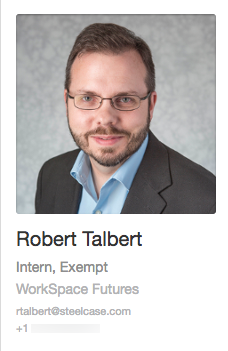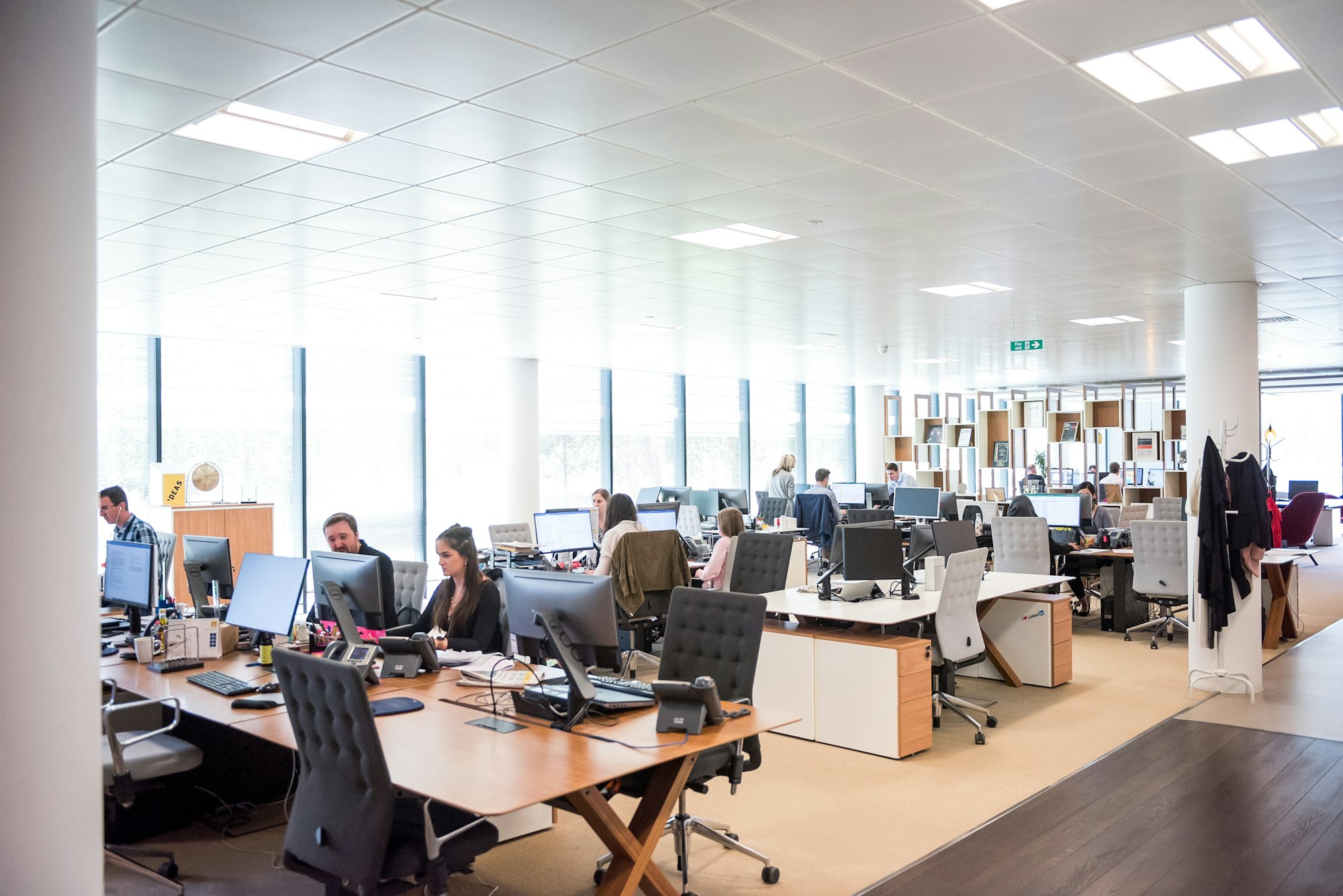Sabbatical lessons, part 0: What I did as an embedded academic

About 223 days ago, I started my first day on the job as an embedded faculty member with Steelcase. It was the first day of my sabbatical as scholar-in-residence with Steelcase Education. Don't be too impressed by the title; according to the employee system, I was just an intern:

Actually "intern" is probably the best lens through which to look at what I've been doing at Steelcase for the last eight months. I was nobody special: Just a guy, at the bottom of the org chart, working with and around a lot of people smarter and more talented than I am in any number of ways, and tasked with making their work and the collective work of the organization better. It's kept me a little bit humbler than I would have been otherwise.
I am now less than 50 days from being done with my time at Steelcase. In the beginning, I planned to chronicle my time in industry with regular blog posts about my experiences on the job in a particular week. I tried this a couple of times, but it became a little boring, because when you look at individual days of work, there was rarely anything worth mentioning; but in the aggregate and over the long haul, I can look back and see many important things I've learned and ways in which I have changed. It's taken 8 months for some of these things to ripen, but now that I'm at that point, it's time to report back. So I am going to spend the better part of the next 5-6 weeks blogging about the Big Ideas that I've come away with through this extended stay in the corporate world.
I've always felt like I was conducting two sabbaticals at the same time. The public sabbatical, the one that I proposed to my university and to Steelcase, centers around being on-site at Steelcase headquarters in Grand Rapids, conducting research on active learning and active learning classrooms and communicating that research to Steelcase audiences and customers[1]. In this public sabbatical, I have learned a ton of new things, mostly about education research methods and what we know from those methods about how learning spaces interact with pedagogy and technology to affect student learning.
But I'm not going to report back on those things for now. Instead, I want to write about my secret sabbatical.
The secret sabbatical (so-called because I didn't really disclose it to Steelcase, also because I want it to sound cooler than it really is) was about using my position as an embedded academic in a corporation to gather all the intel that I can about how private companies work and to see if there's anything that's particularly good that could be adapted and brought back into higher education, to make higher education better.
So for the last eight months, I've asked a lot of questions of the managers and business types that are around me. I've taken part in marathon business strategy planning sessions. I've done design sprints with people high up the org chart. I've read books like The Innovator's Dilemma and others that you'd not typically find in the math section of the bookstore. I've tried to train myself in the lingo and include terms like "design sprint", "customer", "ROI", and so on in my vocabulary. I've kept my eyes open, taken a notebook full of notes, and spent time every day processing what I was seeing and speculating about how the best things I saw might function in higher education. Occasionally I even wrote a blog post about it. While I was an embedded academic with the company, I played amateur anthropologist to learn all I could about corporate practices.
Some of the specific questions I was thinking about while doing this have been:
- What do creativity and innovation look like on a day-to-day basis inside a large organization whose existence depends on staying creative and innovative?
- How do leaders operate within such an organization, where there are a lot of smart people and in which innovation and creativity are of the highest importance?
- What practices of really effective companies, in which creativity and innovation are important, seem to have the biggest impact?
- Is there any chance that higher education can
stealappropriate and modify any of those high-impact practices, that would make higher education better at serving student and helping them succeed?
Let me be clear that this is not about "running higher education like a business". I've made it clear before that I think this is a non-starter, because the basic assumptions and models for businesses are different than those for universities. But this doesn't mean that we can't learn something useful from our friends in the corporate world.
And let me say: If you're an academic and the phrase "friends in the corporate world" is offensive, maybe this is a place to start. There are absolutely some corporations that seem to care nothing for people, that embrace unethical practices as normative and focus only on profit. But there are also plenty of colleges and universities that are the same. And, as I have learned, there are also corporations who, while still focusing on being profitable, manage to have their hearts in the right place, care about their workers and customers, and do really amazing things. The first order of business is to think more critically about businesses.
I've been thinking for the last couple of weeks about the big takeaways from my sabbatical on this issue. It's been hard, because I've learned and experienced so much that it's nearly impossible to distill it all down into a short list, and any short list I could generate will oversimplify things. But insofar as I can manage it, as a preview of what's to come, here's a list of what I think were the biggest lessons I learned:
- Business and higher education have more in common than we academics think.
- Higher education can, and should, study and adapt the practices of highly effective businesses.
- The most important characteristic of great companies, that higher education lacks the most, is agility.
- Innovation is hard work, needs to be scalable, and needs to be everybody's job.
- Workplace culture trumps everything.
- In a great company, everybody assumes responsibility for everything.
- There is great power in a diverse team working with a single purpose.
- College faculty are smart creatives.
- The future of work is a whole lot of both-and's, not either-or's.
- Higher education is at a turning point, and it can either adapt and thrive, or stay put and be irrelevant.
I'll be taking these points one at a time to go deeper into what I mean by each over the coming weeks.
Finally, when I was first hatching this scholar-in-residence idea almost 2.5 years ago, I knew I wanted to do something radically different --- a moon shot that I'd never be able to do while in my regular professor duties or even in a single semester of a sabbatical, and something that would set my professional course for the next 20-30 years. I just want to say that it's been all that and more, and I'll miss the work I'm doing and the people I've worked with when my time's up in a few more weeks.
In the meanwhile, stay tuned to hear what I think I've learned.
I've also been working on two non-Steelcase-related SoTL projects on my "off days". ↩︎


